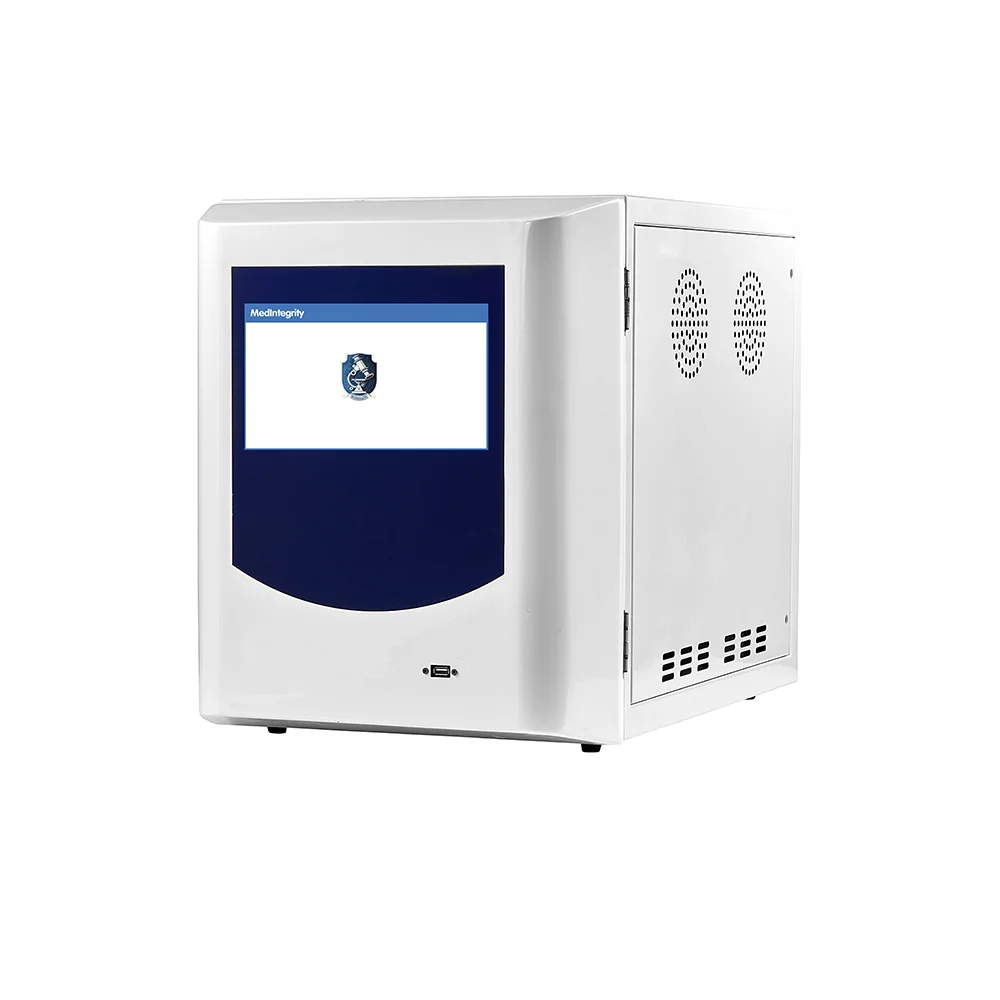How Total Organic Carbon Analyzers Enhance Laboratory Efficiency
How Total Organic Carbon Analyzers Enhance Laboratory Efficiency
In today’s busy lab settings, working quickly and correctly is key. It helps keep results top-notch and meets strict rules. Total Organic Carbon (TOC) analyzers are vital tools for reaching these goals. They shine in drug, environmental, and water treatment labs. At MedIntegriti, we know how important dependable TOC analyzers are for boosting your lab’s work. This blog explains how TOC analyzers function. It shares their benefits and shows how they can improve your lab tasks. We also point out key features to look for and how our solutions help you succeed.

The Fundamentals of Total Organic Carbon Analysis
Total Organic Carbon (TOC) analysis measures the amount of natural carbon in a sample. It acts as a main sign of water cleanliness and impurity levels. Natural carbon comes from natural or man-made sources. It can affect water purity, process flow, and product safety. TOC analyzers find these compounds by turning natural carbon into carbon dioxide (CO2). Then, they measure it with sensitive tools. This process helps labs check water quality. It ensures they follow rules and improve tasks.
TOC analysis is crucial in fields like drug-making, where water purity is a must. It’s also vital in environmental work, where natural pollution must be controlled. By giving quick and correct measurements, TOC analyzers help labs make smart choices fast. This cuts downtime and boosts output.
The Role of Total Organic Carbon Analyzers in Modern Laboratories
TOC analyzers play a big role in today’s labs. They provide exact, real-time data on natural carbon levels. Their ability to speed up testing and improve quality checks makes them essential for many uses.
Benefits of Using TOC Analyzers in Laboratory Settings
TOC analyzers bring several perks that boost lab speed and dependability:
- Great Accuracy: They give precise measurements of natural carbon. This ensures trustworthy data for quality checks.
- Time Savings: Automated steps cut analysis time compared to old methods. Labs can handle more samples.
- Rule Compliance: TOC analyzers help meet tough standards, like those from the FDA, USP, and EPA. This keeps your lab compliant.
- Flexibility: They can test various sample types, from very pure water to dirty water. This suits many industries.
Improving Analytical Accuracy
Accuracy is vital in labs, especially for drug tasks like water for injection (WFI). TOC analyzers use advanced methods, like high-heat burning or UV-chemical reactions, to fully turn natural carbon into CO2. This leads to very accurate measurements. It reduces mistakes and ensures steady results. For example, our TA-200 TOC analyzer is built to give excellent precision for tough tasks.
Reducing Manual Effort and Human Error
Manual testing takes time and can lead to mistakes. TOC analyzers automate key steps, like sample adding and data handling. This cuts the need for human work. It saves time and reduces errors. The results are steady and repeatable. Automated systems also let lab workers focus on more important tasks. This improves overall lab output.
The Main Steps
TOC analysis follows clear steps to measure natural carbon correctly. Knowing these steps helps you see how efficient TOC analyzers are.
Sample Introduction
The process starts by adding the sample to the analyzer. Automated systems, like those in our TA – 3.0 TOC analyzer, ensure exact sample delivery. This reduces differences. Samples can be liquids, like clean or dirty water. They may need pre-treatment, like adding acid to remove non-natural carbon, for accurate results.
Oxidation
Natural carbon in the sample turns into CO2 using one of two main methods:
- High-Heat Burning: Samples are heated to 680–1200°C in an oxygen-rich setting, often with a helper substance. This changes natural carbon to CO2. It works well for samples with lots of particles.
- Chemical Reaction: UV light or chemicals oxidize natural carbon at lower heat. This method suits samples with low carbon levels but may need adjustments for added chemicals.
Detection
The CO2 made is measured with a special infrared detector. It’s very specific to CO2 and gives accurate results. Some analyzers use conductivity-based detection. They measure changes in water conductivity after CO2 dissolves. Both methods ensure reliable measurement of natural carbon levels.
Display
Modern TOC analyzers have easy-to-use screens. They show results in real-time. Data can be saved for further study or stored for rule-following records. Advanced models, like our TA-1.0 TOC analyzer, include built-in software. It makes data handling and reporting smooth.

Enhancing Laboratory Efficiency with TOC Analyzers
TOC analyzers change how labs work. They make testing easier, cut resource waste, and ensure rule-following. This greatly boosts lab speed.
Streamlining Routine Testing Processes
TOC analyzers simplify regular testing. They automate sample handling, oxidation, and detection. This cuts analysis time from hours to minutes. Labs can process more samples daily. For example, in drug labs, constant water purity checks quickly spot impurities. This prevents costly delays.
Optimizing Resource Utilization Through Automation
Automation drives efficiency. TOC analyzers with autosamplers and real-time monitoring reduce manual sample prep and analysis. This saves worker time and cuts chemical use. Also, automated systems can run multiple samples in a row. This increases output without losing accuracy.
Supporting Regulatory Compliance and Quality Assurance
Following rules like USP <643> and EPA standards is key for drug and environmental labs. TOC analyzers give accurate, recorded results. These support quality checks and rule audits. Real-time monitoring lets labs spot and fix issues right away. This ensures compliance and protects product safety.
Features to Look for in a Total Organic Carbon Analyzer
Picking the right TOC analyzer is vital for max lab efficiency. Here are key features to consider:
Sensitivity and Detection Limits
High sensitivity is crucial for finding low natural carbon levels, especially in very pure water tasks. Look for analyzers with detection limits below 50 ppb for drug and tech labs. Our TA-200 model offers great sensitivity for trace-level tests.
Data Management Capabilities
Good data handling is key for compliance and analysis. Choose analyzers with:
- Built-In Software: For real-time data display, storage, and export.
- Calibration Tracking: To keep performance steady and meet rules.
- Remote Monitoring: For off-site checks and problem-solving.
These features make data handling easy and improve lab speed.
Maintenance and Calibration Requirements
Low-upkeep analyzers cut downtime and costs. Look for models with:
- Self-Check Tools: To alert users to upkeep needs, like UV lamp changes.
- Modular Design: For easy upkeep and part replacement.
- Automated Calibration: To simplify routine care and ensure accuracy.
Analyzers with these features, like ours, keep disruptions low and labs running well.
MedIntegrity: A Trusted Supplier of Total Organic Carbon Analyzers
At MedIntegriti, we focus on giving top-quality TOC analyzers. They suit drug, environmental, and industrial labs’ needs. With over 15 years of experience, we deliver dependable solutions that meet strict rule standards.
Overview of MedIntegrity’s Product Range
We offer a wide range of TOC analyzers. They are designed for precision and ease. Our products, like the TA-200 series, handle various tasks, from very pure water testing to dirty water analysis. Each analyzer is built for accurate results and low upkeep. This keeps your lab efficient.
Commitment to Quality and Customer Support
We take pride in putting customers first. Our team gives expert advice on picking the right analyzer for your needs. We also provide full support for setup, training, and upkeep. Trusted by big names like Sunny Pharmaceutical and BeiGene USA, we ensure our products meet FDA, GMP, USP, and EP standards. Contact us to learn how we can help your lab’s goals.
Conclusion: The Impact of TOC Analyzers on Laboratory Performance
Total Organic Carbon analyzers are powerful tools. They boost lab efficiency with accurate, fast, and automated analysis. They streamline testing, save resources, and ensure rule-following. This helps labs achieve better output and dependability. At MedIntegrity, we’re dedicated to helping you use TOC analyzers to meet your work and rule needs. Let us work with you to lift your lab’s performance.
FAQs About Total Organic Carbon Analyzers
Q1 What is the primary purpose of a TOC analyzer?
A1 A TOC analyzer measures natural carbon in a sample. It’s a key sign of water cleanliness and impurity levels. It helps labs check purity, ensure process flow, and meet rule standards in fields like drug-making and environmental monitoring.
Q2 Can TOC analyzers be used across different industries?
A2 Yes, TOC analyzers are flexible and used in:
- Drug-Making: To check water for injection and purified water.
- Environmental: To measure natural pollution in dirty and natural water.
- kuasa: To ensure water quality in boiler and cooling systems.
- Tech: To maintain very pure water for manufacturing.
Their flexibility makes them vital across many fields.
Q3 How often should a TOC analyzer be calibrated?
A3 Calibration timing depends on the analyzer and task. Generally, calibrate every 6–12 months or as the maker suggests. Regular calibration ensures accuracy and meets standards like USP <643>. Automated calibration in our analyzers makes this easier.







